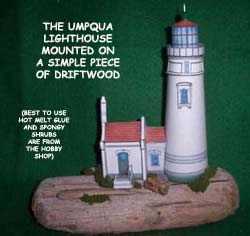

Umpqua River Lighthouse

Still active, is one of the few lights along the Pacific Coast that emits both red and white flashes. Built in 1894 in Winchester Bay, the 65-foot stucco-covered masonry tower stands 165 feet above sea level and can be seen up to 19 miles out to sea.


Umpqua River Light House, Central Coastal Oregon

California became an organized territory in 1847 and Oregon (including present-day Washington) the following year Almost immediately, Congress recognized the need to locate a network of lighthouses along their unlit West Coast shores. In 1848, lawmakers directed the Coast Survey to investigate and recommend the most logical places. The search team's findings proposed establishing a total of sixteen lights-twelve in California; three in Washington; and one in the Beaver State.
The choice in Oregon was at the entrance to the Umpqua River, 19 miles north of Coos Bay. Construction began in 1855. on the north spit at the river's mouth, and the finished brick tower was first lit in the fall of 1857. Unfortunately, engineers had mistakenly located the lighthouse on a sandy plain, and when the river flooded, it undermined the structure. In February 1861, high water all but capsized the light, and during an October 1863 storm, it did fall. Instead of rebuilding the overturned aid, the Lighthouse Board decided to abandon it and establish a new station at Cape Arago, 25 miles to the south.
Even without the lighthouse, commerce along the Umpqua River continued to thrive, and the calls for another beacon did not go away. In 1888, federal legislators responded with a $50,000 appropriation and instructed the Lighthouse Board to find a suitable location for a first-class light near the Umpqua's mouth.
Engineers selected a site south of the entrance, on high ground well back from the water Workers completed the tower and surrounding buildings early in 1893, although when crews tried to install the first-order Fresnel lens, they found that the metal base for the apparatus which supported and rotated the light was 15 inches too short. Work had to be suspended more than 18 months, until Congress appropriated another $2,371 for the proper pedestal. The new Umpqua River Light went on 31 December 1894.
Umpqua River Lighthouse is almost identical to Heceta Head but is slightly taller at 65 feet high. Its setting is not nearly so picturesque, surrounded by buildings and sitting next to the road.

This lighthouse was the second lighthouse built on the Umpqua River. The first one was the first lighthouse to be built on the Oregon Coast in 1857 and until recently was thought to have stood on the north side of the river. however, a new survey confirmed that the first lightl1ouse was located just upriver from the mouth of the Umpqua on the south side, according to Ed St. John, volunteer resident lighthouse caretaker and tour guide. St. John works under the direction of the Douglas County Parks and Recreation Department, the public agency in charge of the lighthouse structures.
This lighthouse, like Heceta Head, also has a first order Fresnel
lens-with about 600 prisms. But this lens has 24 bull's-eye lenses
of which six are red. St. John says, "It's the most beautiful
light on the coast!" Among experts it's considered a jewel
of a Fresnel lens with those red bull's-eye lenses. At night the
light has white and red characteristic flashes and is still used
as an aid to navigation maintained by the Coast Guard.
The lighthouse is situated close to other sites worth seeing: across the road is the whale-watch platform, next door is Umpqua Lighthouse State Park, and about 200 yards away is the Coastal Visitors Center in the old Coast Guard building with historical exhibits as well as visitor information.
Viewing spot: On site, Lighthouse Way south of Reedsport.




